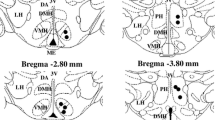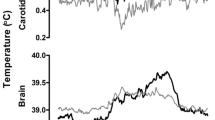Abstract
Ducks were chronically implanted with thermodes in the POAH region, the lower brainstem or the vertebral canal. At thermoneutral conditions, lowering the temperature of the spinal cord (Tvc) or the lower brainstem (Tmb) stimulated metabolic heat production (M) with a subsequent rise of core temperature (Tc). Lowering the temperature of the POAH region (Thy) induced a fall of Tc due to paradoxical activation of heat defence and, thus, induced slight to moderate general hypothermia depending on the cooling intensity. When Thy was normalized, the hypothermia temporarily stimulated metabolic heat production until Tc was normalized. Cold sensitivity of the entire body, as revealed by the metabolic response to the hypothermia induced by preceding POAH cooling, and cold sensitivity of the spinal cord and the lower brainstem, as revealed by the metabolic response to local cooling, were quantified by calculating the quotient δM/δT from the maximum metabolic response and the experimentally induced drop of Tc, Tmb and Tvc. With lower brainstem cooling δM/δTmbdid not exceed −0.4 W/(kg · ‡C). With spinal cord cooling, δM/δTvc did not exceed −0.6 W/(kg · ‡C). The mean value of δM/δTc after hypothermia induced by POAH cooling was −4.02 W/(kg · ‡C). The results indicate that the cold sensitivity residing in the CNS of ducks represents only a small fraction of the entire cold sensitivity of the body.
Similar content being viewed by others
References
HAMMEL, H. T. (1968): Regulation of internal body temperature. Ann. Rev. Physiol., 30: 641–710.
HAMMEL, H. T., MAGGERT, J., KAUL, R., SIMON, E. and SIMON-OPPERMAN, Ch. (1976): Effects of altering spinal cord temperature on temperature regulation in the Adelie penguin (Pygoscelis Adeliae). Pflügers Arch., 362: 1–6.
HAMMEL, H. T., MAGGERT. J., SIMON, E., CRAWSHAW, L. and KAUL, R. (1977): Thermo- and osmo-regulatory responses induced by heating and cooling the rostral brain stem of the Adelie penguin. In: Adaptations Within Antarctic Ecosystems. G. A. Llano (ed.) Washington D.C., Smithsonian Inst., 489–500.
JESSEN, C. and MAYER, E. Th. (1971): Spinal cord and hypothalamus as core sensors of temperature in the conscious dog: I. Equivalence of responses. Pflügers Arch., 324: 189–204.
MERCER, J. B. and JESSEN, C. (1978): Effects of total body core cooling on heat production of conscious goats. Pflügers Arch., 373: 259–267.
RAUTENBERG, W. (1969): Die Bedeutung der zentralnervösen ThermosensitivitÄt für die Temperaturregulation der Taube. Z. vergl. Physiol. 62: 235–266.
RAUTENBERG, W. (1971): The influence of skin temperature on the thermoregulatory system of pigeons. J. Physiol. (Paris), 63: 396–398.
RAUTENBERG, W. and NECKER, R. (1975): A comparison between peripherally and centrally generated cold sensitive signals in regulating heat production of the pigeon. In: Depressed Metabolism and Cold Thermogenesis, L. Jansky (ed.), Prague Charles University, 224–227.
RAUTENBERG, W., NECKER, R. and MAY, B. (1972): Thermoregulatory responses of the pigeon to changes of the brain and spinal cord temperatures. PflLügers Arch., 338:31–42.
RAWSON, R. O. and QUICK, K. P. (1970): Evidence of deep-body thermoreceptor response to intra-abdominal heating of the ewe. J. appl. Physiol., 28: 813–820.
RICHARDS, S. A. and AVERY, P. (1978): Central nervous mechanisms regulating thermal panting. In: Respiratory Function in Birds, Adult and Embryonic. J. Piiper (ed.), Springer, Berlin — Heidelberg, 196–203.
RIEDEL, W., SIAPLAURAS, G. and SIMON, E. (1973): Intra-abdominal thermosensitivity in the rabbit as compared with spinal thermosensitivity. Pflügers Arch., 340: 59–70.
SCHMIEG, G., MERCER, J. B. and JESSEN, C. (1980): Thermosensitivity of the extrahypothalamic brain stem in goats. Brain Res., 188: 383–397.
SIMON, E. (1974): Temperature regulation: the spinal cord as a site of extrahypothalamic thermoregulatory functions. Rev. Physiol. Biochem. Pharmacol. 71: 1–76.
SIMON, E., HAMMEL, H. T. and OKSCHE, A. (1977): The thermosensitivity of single units in the hypothalamus of the conscious Pekin duck. J. Neurobiol. 8: 523–535.
SIMON, E., SIMON-OPPERMAN, Ch., HAMMEL, H. T., KAUL, R. and MAGGERT, J. (1976): Effects of altering rostral brain stem temperature on temperature regulation in the Adelie penguin (Pygoscelis Adeliae). Pflügers Arch. 362: 7–13.
SIMON-OPPERMANN, Ch. and MARTIN, R. (1979): Mammalian-like thermosensitivity in the lower brainstem of the Pekin duck. Pflügers Arch., 359: 291–293.
SIMON-OPPERMANN, Ch., SIMON, E., JESSEN, C. and HAMMEL, H. T. (1978): Hypothalamic thermosensitivity in conscious Pekin ducks. Amer. J. Physiol., 235: R130-R140.
SNAPP, B. D., HELLER, C. H., and GOSPE Jr., S. M. (1977): Hypothalamic thermosensitivity in California quail.Lophortyx californicus. J. comp. Physiol., 117, 345–357.
Author information
Authors and Affiliations
Rights and permissions
About this article
Cite this article
Simon, E., Martin, R. & Simon-Oppermann, C. Central nervous versus total body thermosensitivity of the duck. Int J Biometeorol 25, 249–256 (1981). https://doi.org/10.1007/BF02184526
Issue Date:
DOI: https://doi.org/10.1007/BF02184526




